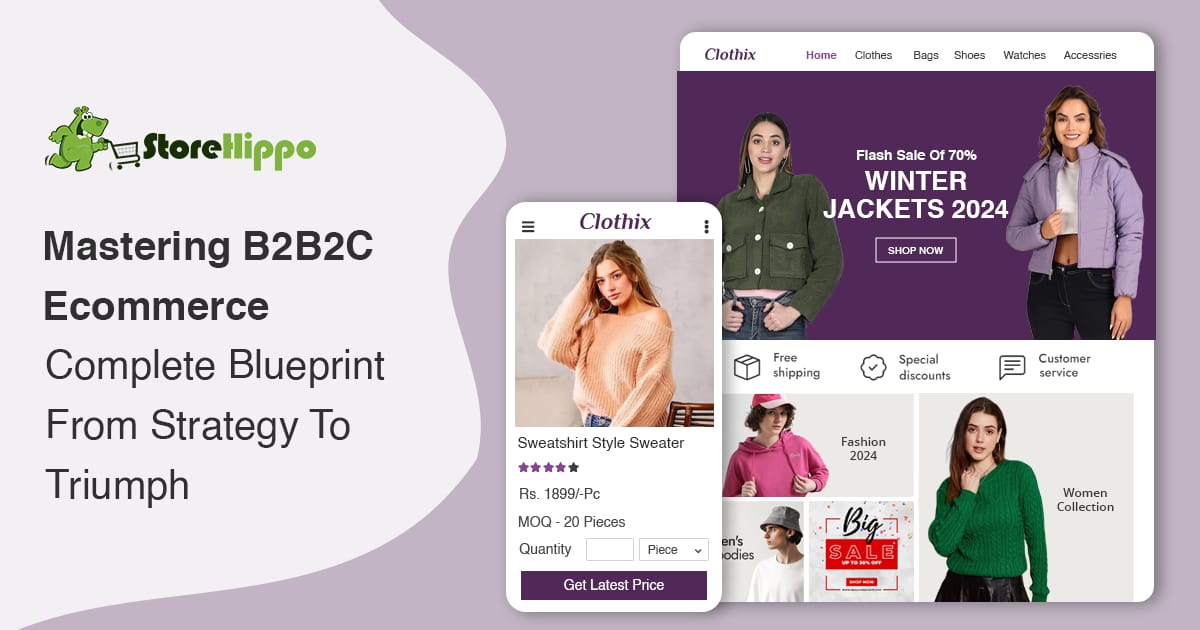B2B2C Ecommerce is the game-changer business model for enterprise brands.
Wonder why?
Well, there are many reasons but the 2 most important ones are:
- The B2B2C business model combines the goodness of B2B and B2C to give enterprises access to a wider market and customer base
- The parent enterprise brand along with its partner businesses can offer customers products and services which were otherwise difficult to offer by either of them
In nutshell, B2B2C ecommerce enables your enterprise to collaborate, differentiate and disrupt the market with its unique offerings.
Wasn’t this that you always wished to achieve for your brand?
You certainly did!
Table of Contents
- Why B2B2C Ecommerce is the Right Move for Enterprise Brands
- What is B2B2C Ecommerce
- How does the B2B2C Ecommerce Model Work
- How B2B2C Ecommerce is a Win-Win Business Model
- How B2B, B2C and B2B2C Business Models are Different and Unique
- Why enterprise brands are pivoting to B2B2C Ecommerce in 2024
- Which businesses are a good fit to adopt the B2B2C Ecommerce Model
- Challenges of Implementing the B2B2C Ecommerce Model (And How to Overcome It)
- Lack of Planning
- Finding the Right Technology Partner
- Streamlining, Standardising and Modernizing Processes
- Brand Consistency
- Catering to Diverse Customer Base
- Ease of Doing Business
- Scalability and Flexibility
- Building Omnichannel Personalised Buyer Journeys
- Integrating existing and new software and services
- Trust and Relationships
- Charting Success: Your B2B2C Ecommerce Transition Blueprint
- Bridging the Gap: Tech Requirements to Ace B2B2C Ecommerce
- Offer Wow User Experience
- Build Omnichannel B2B2C Marketplace
- Sell Better With M-Commerce
- Connect and Convert With Personalization
- Talk In The Language Your Buyers Love
- Make Doing Business Easy
- Frictionless Payments and Payouts
- Logistics and Delivery Management
- Market Your Way To Success
- Future-Proof your B2B2C Business
- B2B2C Brands That Have Made A Mark: How Leveraging Partnerships Skyrocketed Sales
- Unlocking Disruptive Growth for Your Brand with B2B2C Ecommerce
- Conclusion
Why B2B2C Ecommerce is the Right Move for Enterprise Brands
The ecommerce landscape has witnessed tectonic shifts in the past few years. With the pandemic-induced accelerated adoption of ecommerce and changing buyer preferences, enterprise brands needed a transformative business model that worked better than the B2B and B2C models.
The post-pandemic world demands a business strategy designed to weather uncertainty and disruption and seize opportunities for growth and resilience. The B2B2C or Business-to-Business-to-Consumer ecommerce model does exactly that. The avant-garde business model enables enterprises to blend B2B efficiency and B2C customer-centricity to create tailored business ecosystems where every stakeholder wins.
By implementing B2B2C ecommerce enterprise brands can connect directly with the end customers and create a seamless, value-driven ecosystem that works as a catalyst for unprecedented enterprise growth.
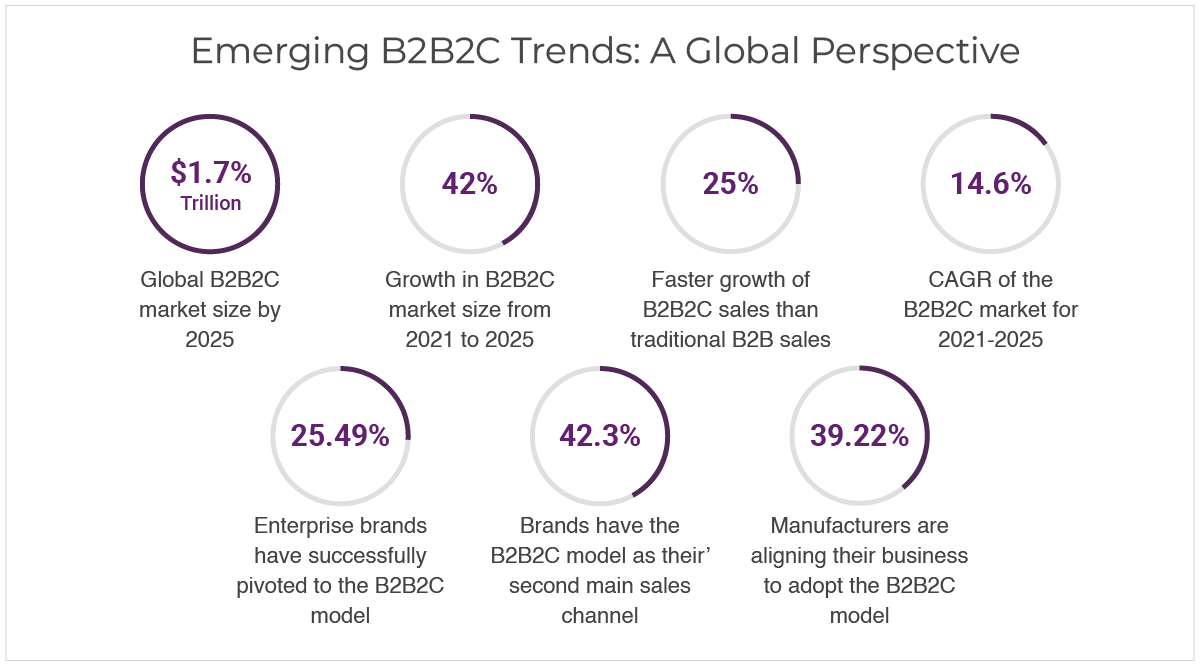
- $1.7 trillion will be the global B2B2C market size by 2025
- 42% growth in B2B2C market size from 2021 to 2025
- 25% faster growth of B2B2C sales than traditional B2B sales
- 14.6% CAGR of the B2B2C market for 2021-2025
- 25.49% of enterprise brands have successfully pivoted to the B2B2C model
- 42.3% of the brands have the B2B2C model as their’ second main sales channel
- 39.22% of manufacturers are aligning their business to adopt the B2B2C model
Source: Forrester Research, MarketsandMarkets, Grand View Research, Copperberg
The B2B2C market is poised for enormous growth and enterprises adopting it early on can be at the forefront of transformation and unrestrained growth. A B2B2C marketplace not only opens up new avenues for enterprises planning to widen their reach but can also give your business the flexibility to experiment, innovate and implement disruptive business liaisons for unlocking growth opportunities.
B2B2C Ecommerce bringing in an era of Possibilities and Disruption for Enterprises
New, never-before business models have become a norm in the ecommerce world. Rather than sticking solely to either B2B or B2C models, enterprise brands are actively exploring diverse hybrid business models and strategies, capable of achieving transformative growth.
The latest survey revealed how brands are going for multiple business models at the same time.
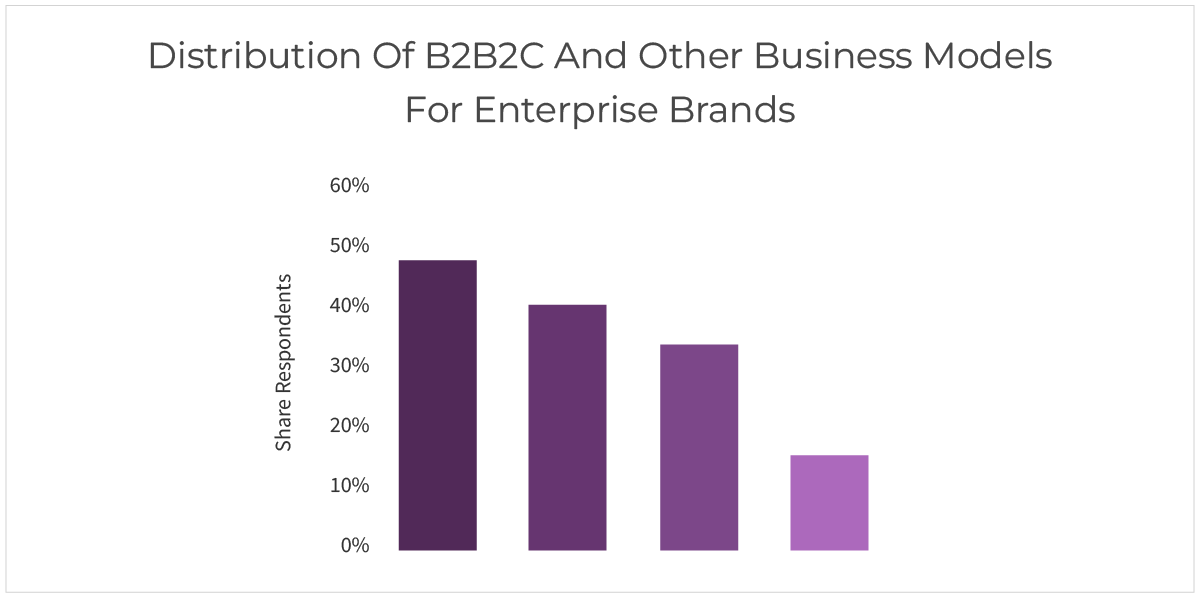
Source: Statista
In the above chart, the sum total of all the business models implemented by enterprises is over 100%, which underlines the fact that brands are experimenting with different business models. Such a setup fosters greater opportunities for experimentation, product launches, and the identification of optimal market-product-channel combinations, facilitating strategic growth
What is B2B2C Ecommerce
B2B2C ecommerce or business-to-business-to-consumer is a business model which involves a setup where a parent business in collaboration with other businesses sells products or services to the end consumers.
By opting for B2B2C Ecommerce enterprise brands can cater to two diverse audiences, viz, other businesses ( who act as partners) and eventually the end customers through the other businesses. With the B2B relationships at the core, the parent brand leverages the individual partners' skills and domain expertise to reach a wider audience base.
The partners benefit from the brand reputation, tech infrastructure and additional support ( marketing, supply chain, branding etc.) offered by the parent brand.
The end buyers identify with the parent brand and not the individual partners from whom they purchase products or services.
The B2B2C marketplace offers disruptive growth opportunities due to the strong connections and cooperative possibilities between the B2B (business-to-business) and B2C (business-to-consumer) sales channels.
How does the B2B2C Ecommerce Model Work
Let us understand the B2B2C business model with the example of a food delivery aggregator platform that onboards various food joints as partner businesses (B2B part of the business model) and offers some services to these partners to eventually serve the end customers( B2C part of the business model).
- In a food delivery B2B2C Marketplace set-up, a parent brand sets up a food delivery aggregator business under its brand name.
- Local food joints and restaurants are onboarded on the marketplace platform.
- The parent brand helps these restaurant partners by offering tech solutions to go online and reach a wider customer base. Parent brand also helps with supply chain solutions to streamline time delivery using its rider network.
- Restaurants bring in their loyal customers onboard who then order from other restaurants also.
- Having multiple location-based restaurants helps the parent brand reap the benefits of hyperlocal commerce
- Parent brand also helps with marketing by offering different discounts, cashback offers etc. which boost orders for individual sellers as well as the B2B2C marketplace brand.
- The parent brand earns commissions on each order placed.
- There can be other revenue sources as well for the parent brand like- premium memberships, ads on the platform, prime positioning of partner businesses, collaborations with payment partners etc.
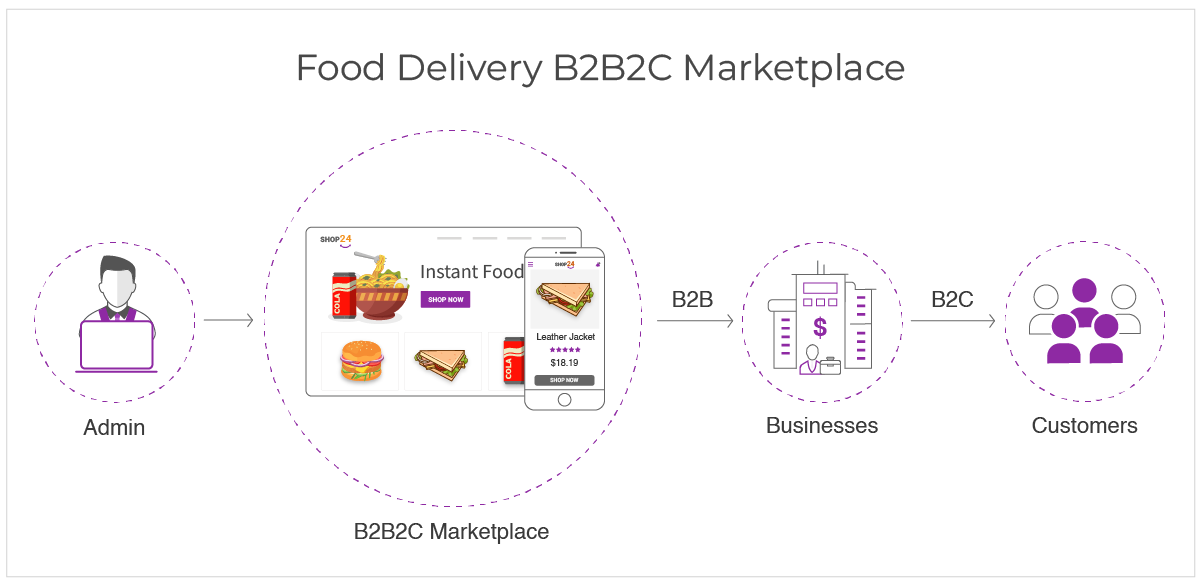
How B2B2C Ecommerce is a Win-Win Business Model
Having a B2B2C brand is beneficial for your enterprise as well as its partner businesses and end customers. The collaborative set-up of the business-to-business-to-customer model and how each party participates and benefits from it can be best understood by the following comparative table.
For ease of understanding we are taking the same example as above, i.e, the food delivery aggregator platform having a B2B2C company.
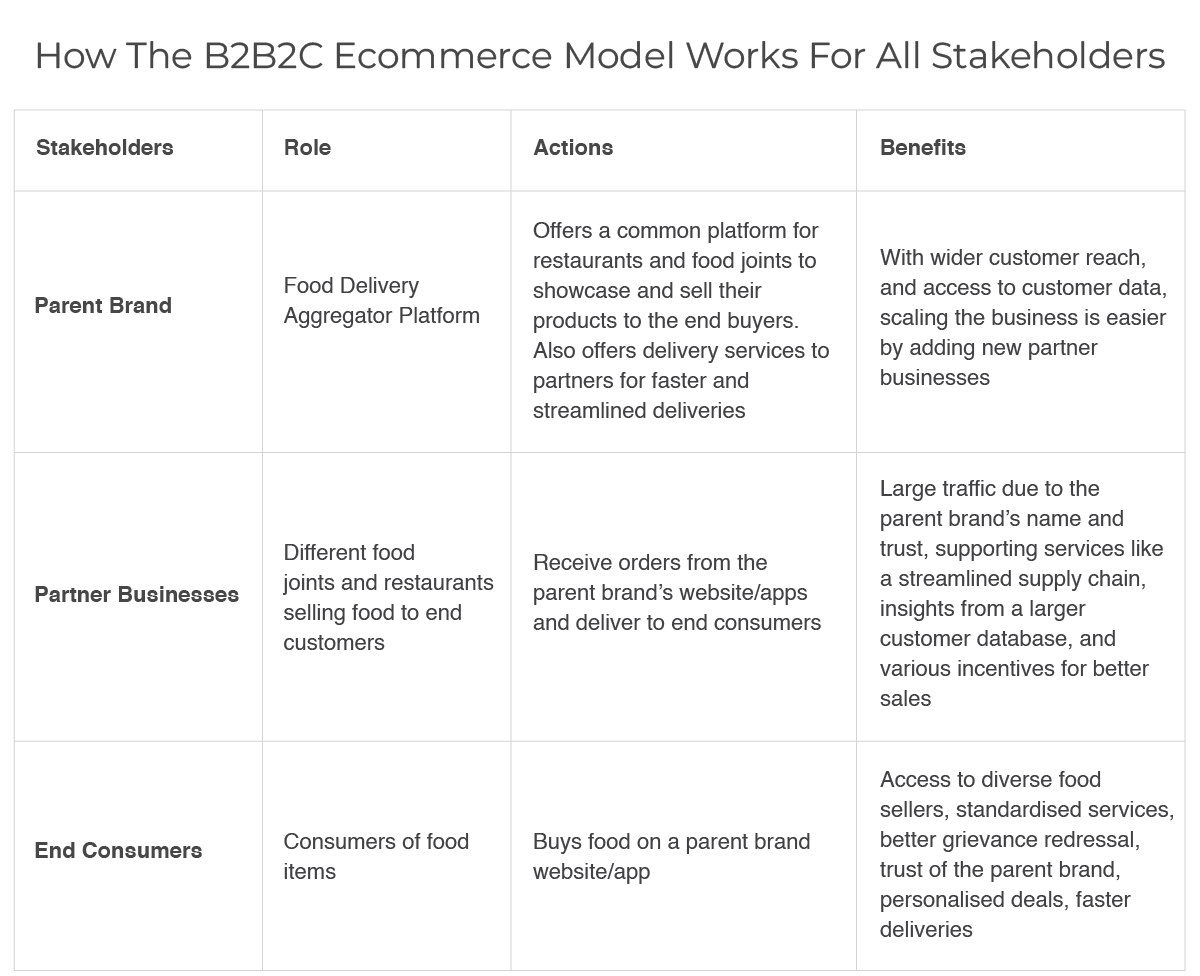
Pivoting to the B2B2C ecommerce model has helped brands in the online food ordering, grocery, FinTech, MediTech, home services, real estate, recruitment and other sectors register unparalleled growth and lower customer acquisition costs.
How B2B, B2C and B2B2C Business Models are Different and Unique
While B2B2C ecommerce combines both B2B and B2C models it is still unique from either of the models. Here is how each of these models connects with the customers.
The following table gives a comparison of how business is done in each of the B2B, B2C and B2B2C ecommerce models.
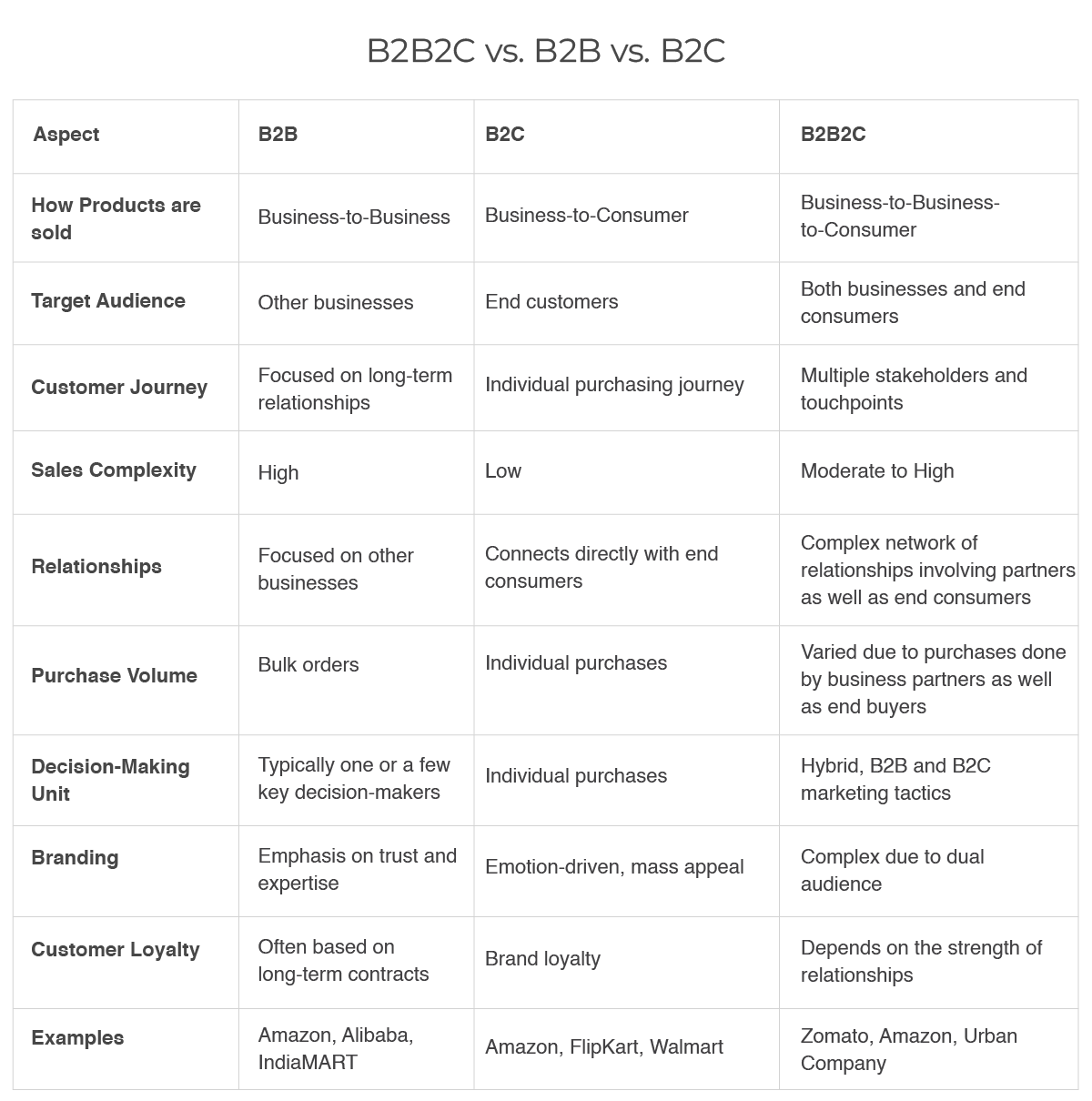
Why enterprise brands are pivoting to B2B2C Ecommerce in 2024
The growing number of B2B2C (business-to-business-to-consumer) marketplaces reflects a shift in business strategy which is aligned towards growing business by knowing customers. Here are some key factors contributing to the widespread adoption of the B2B2C ecommerce model:
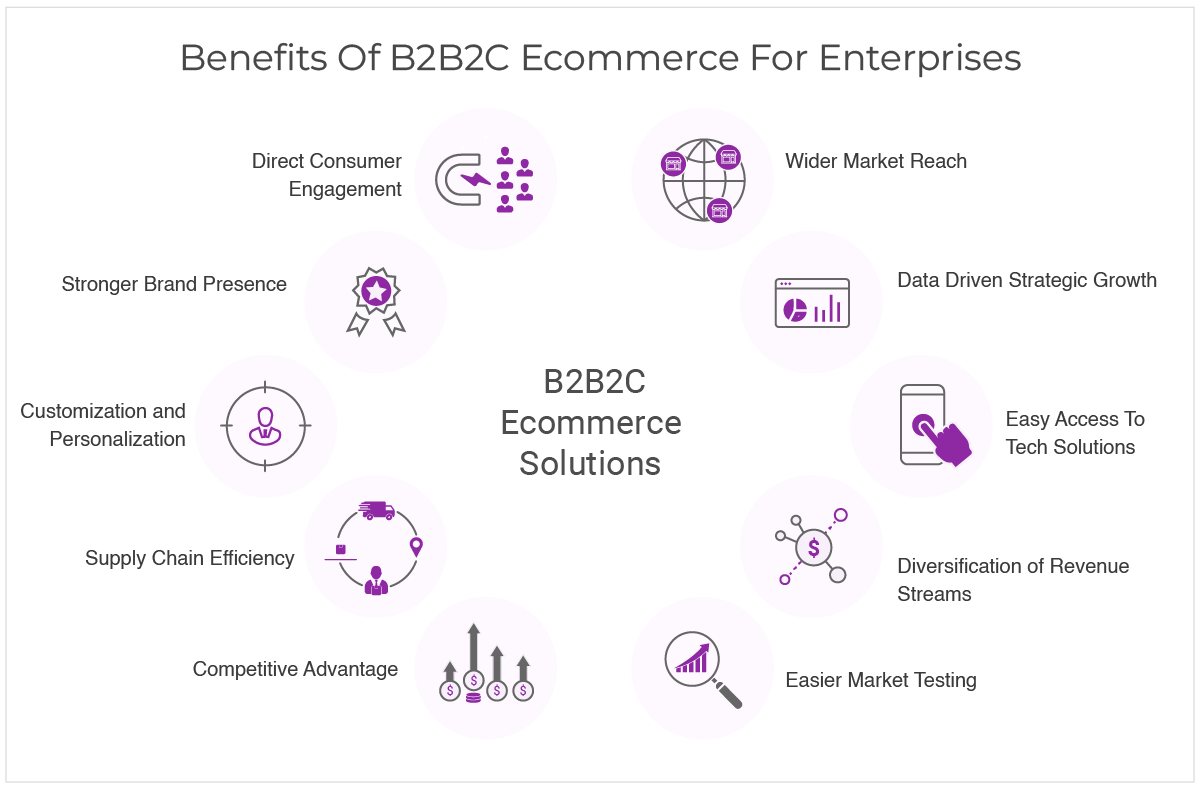
Direct Consumer Engagement
B2B2C ecommerce enables enterprise brands to engage directly with end consumers. By connecting directly with their buyers brands can gather valuable insights into consumer preferences, behaviors, and feedback. Such useful insights help brands to tailor their offerings to meet customer demands more effectively.
Wider Market Reach
The reach of traditional B2B businesses is limited to a specific domain and a small number of clientele. Pivoting to B2B2C ecommerce opens up new markets as brands cater to a wider end consumer base. This also opens up the opportunity to diversify to newer segments and industry verticals.
Stronger Brand Presence
Selling directly to consumers, businesses can build stronger brand recognition and consumer trust. This goes a long way in building long-term customer loyalty and a competitive advantage.
Data Driven Strategic Growth
Direct consumer engagement gives brands access to wide-ranging data about customer preferences and behavior. By leveraging this data B2B2C brands can make strategic decisions about product development, inventory management, marketing and growth.
Customization and Personalization
B2B2C models often have a greater scope for customization and personalization vis-a-vis products and services. Offering tailored products, deals and services leads to higher customer satisfaction and increased sales as the offerings are aligned with buyer preferences and needs.
Easy Access To Tech Solutions
With the acceleration of ecommerce and a host of turnkey ecommerce platforms to build, run and grow the digital presence, it has become easier for enterprise brands to pivot to the B2B2C ecommerce model.
Supply Chain Efficiency
The B2B2C model often requires businesses to optimize their supply chains to accommodate both business clients and end consumers. This optimization and inter-relationship between B2B and B2C segments introduces cost efficiency, better supply chain management and operational efficiency conducive to business growth.
Diversification of Revenue Streams
The B2B2C marketplace helps enterprise brands multiply and diversify their revenue stream. Instead of relying just on B2B sales, brands are able to reach a large number of seller partners, get regular commissions per order, earn from prominent positioning, ads, collaborations and many other revenue sources.
Competitive Advantage
Implementing the B2B2C model gives brands a competitive advantage over peers who are still working with siloed business models. With interactions with both audience segments, i.e. B2B and B2C, B2B2C companies are better positioned to adapt to changing market dynamics and consumer preferences.
Easier Market Testing
B2B2C ecommerce gives brands the right launchpad to test different product-market mixes. By trying products and services in diverse markets, directly to the customers, brands can gain better insights into product acceptance, interests and trends helping them chart their growth plan backed by actual data inputs.
Adopting the B2B2C ecommerce model offers businesses the opportunity to leverage the power of direct consumer engagement, digital technology, and data-driven decision-making. This approach gives a competitive edge to enterprises and helps them expand their reach, build a strong market presence and drive revenue growth.
Which businesses are a good fit to adopt the B2B2C Ecommerce Model
The Business-to-Business-to-Consumer model is a good fit for a lot of industries. Following are a few industries that have already successfully implemented the hybrid model to their advantage:

Food and Beverages Industry
Food delivery aggregator platforms like Zomato and Swiggy are a huge hit among end buyers. The parent brand brings restaurants or food joints to a B2B2C marketplace which then enables sellers to reach a wider audience.
Food and beverage manufacturers can also implement the model by leveraging their dealer-distributor network and building B2B + B2C online stores using advanced B2B2C software.
Grocery Industry
Grocery and daily essentials businesses like Blinkit, Zepto, and BigBasket are successful B2B2C ecommerce companies that serve the end buyers using local sellers and Kirana stores as partner sellers.
Travel Industry
Travel booking B2B2C ecommerce platforms and tour operators like Make My Trip, Goibibo, Clear Trip etc. partner with airlines, hotels, local activity providers etc. to create package deals for consumers. The travel portal is the intermediary between the service providers and the end customers.
Healthcare and Pharmaceuticals
Pharmaceutical manufacturers can build a pharmacy B2B2C ecommerce platform where they can have wholesalers, dealers, distributors etc. who sell to other pharmaceutical retailers as well as end buyers.
Healthcare B2B2C marketplaces like Practo, 1 Mg. , Netmeds etc. that arrange doctor consultations and diagnostics and pathlab facilities also are distributors or pharmacies, who then dispense them to consumers. Similarly, health insurance companies can partner with healthcare providers to offer services to consumers.
Service Providers
Business-to-Business-to-Consumer model can also apply to service providers like B2B2C software companies, where they provide software solutions to other businesses, which then offer those solutions to consumers as part of their services.
Service providers like Urban Company that offer a range of services for home cleaning and repair, grooming etc. using partner service providers also fall under the B2B2C business model. EduTech brands like BYJU’s, upGrad etc. also use the B2B2C model for their business.
Real Estate
Real estate platforms like Magic Bricks, 99 Acres etc. also follow the B2B2C marketplace model where they connect property developers, individual property owners or sellers with real estate agents, who then connect with homebuyers or renters.
Agritech
Agritech B2B2C ecommerce platforms like DeHaat, Ninjacart etc. connect farmers, seed and fertilizer sellers, and agri loan providers with each other and can also act as an intermediary to connect farmers with end buyers. This model can have both B2B and B2C online stores for different audience segments.
While these are some most popular examples of B2B2C businesses, the versatile business model can be a good fit for many other industry verticals like automobile and spare parts businesses, cakes-flowers and gifting brands, Fintech brands, enterprise manufacturing brands and many more.
Challenges of Implementing the B2B2C Ecommerce Model (And How to Overcome It)
Though the B2B2C (business-to-business-to-consumer) ecommerce model offers an opportunity for unprecedented growth, the actual implementation comes with several challenges.
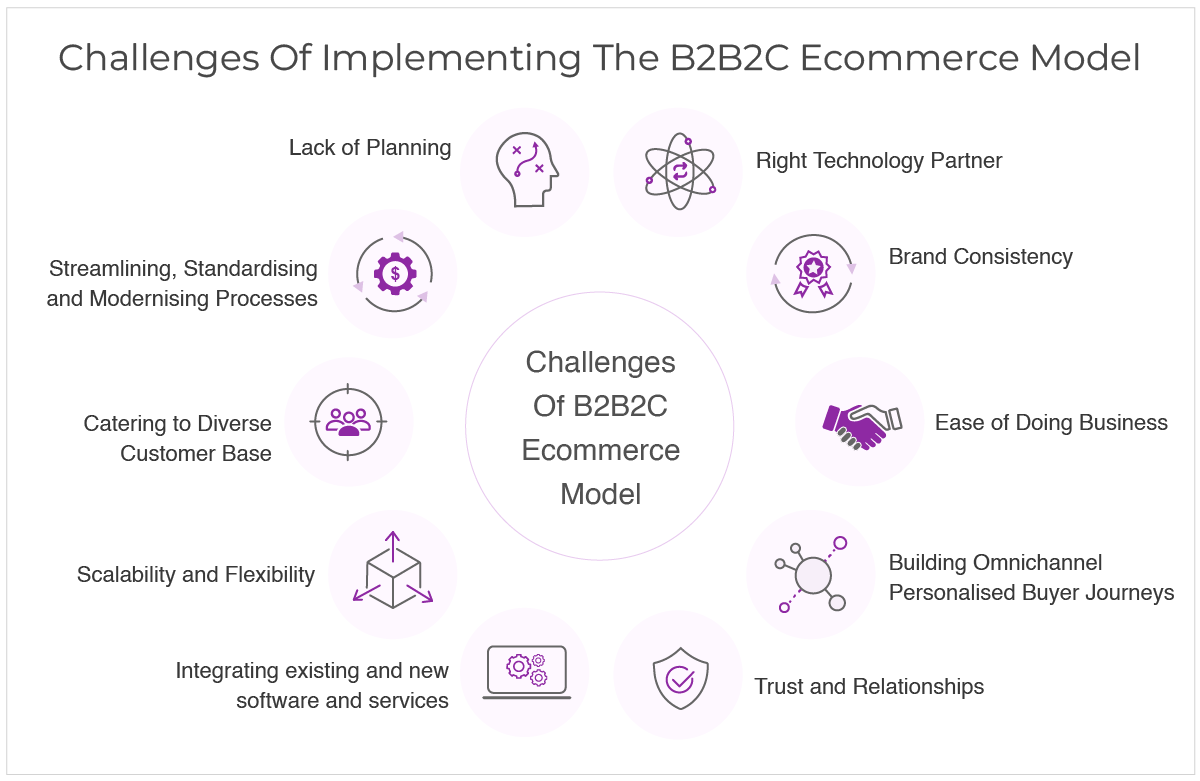
Here are some of the key challenges brands face while implementing the B2B2C ecommerce model along with their solutions:
Lack of Planning
Transitioning to the B2B2C ecommerce model requires thorough evaluation and planning with clear goals to make the business a success. Both the B2B and B2C segments have diverse requirements. Also, the synergies between the B2B and the B2C part of the business need to be thought through and planned in advance.
Tips To Overcome
- Chalk out an elaborate plan which lists down the purpose, key milestones and execution strategies( with timelines) for your B2B2C ecommerce transition.
- Conduct thorough market research and customer segmentation to understand both B2B and B2C needs.
Finding the Right Technology Partner
Implementing multiple flows and processes of the B2B2C marketplace is a complex process. Finding an enterprise ecommerce platform that offers scalable and flexible tech infrastructure to support B2B and B2C operations along with the ability to accommodate existing business/ software/services integrations can be costly and complex.
Tips To Overcome
- Go with a B2B2C ecommerce platform with a proven track record in handling Enterprise B2B and B2C businesses and built-in solutions for the business-to-business-to-consumer model.
- Look for a fully integrated scalable, flexible and secure ecommerce platform that can build tailored solutions for unique business needs.
Streamlining, Standardising and Modernizing Processes
Efficiently managing inventory, orders, customers and processes in a standardized manner across various partners is crucial for the clear visibility, transparency and ultimately the success of the enterprise. However, due to multiple stakeholders, two diverse audience segments ( namely B2B partners and B2C clients) and lack of right technical expertise can complicate the process.
Tips To Overcome
- Conduct a thorough process audit to identify the areas and processes that need improvement, automation and standardization.
- Build an easy-to-use, transparent and well-connected B2B2C ecommerce platform that gives clear visibility, standard processes and automates manual tasks to remove inefficiencies and human errors.
Brand Consistency
Maintaining a consistent brand image and customer experience across different partners, channels and locations can be challenging. Ensuring that each entity upholds the brand's values and standards is crucial for building a reputable B2B2C business.
Tips To Overcome
- Develop clear brand guidelines and communication standards to ensure consistency across all B2B and B2C touchpoints.
- Provide training and resources to B2B partners to ensure they understand brand priorities, standards and ethics and effectively represent the same throughout the ecosystem.
Catering to Diverse Customer Base
B2B2C brands need to cater to both business customers( partner businesses) and end consumers ( B2C buyers). This means having a deep understanding of the distinct needs and preferences of both segments and tailoring offerings accordingly.
Tips To Overcome
- Segment and personalize marketing and customer support efforts to address the unique needs and preferences of both B2B and B2C customer segments.
- Create customized product/service catalogs and pricing structures for B2B and B2C customers and tailor the offerings to their distinct requirements.
Ease of Doing Business
While the prospects of the B2B2C set-up are exceptionally growth-oriented, giving each stakeholder freedom to run and grow their business while managing all stakeholders, services, marketing etc from one central control can be a mammoth task. Offering ease of doing business to all parties remains a challenge for B2B2C marketplace owners.
Tips To Overcome
- Implement a user-friendly and intuitive interface for B2B partners and B2C customers to simplify ordering, payment, and communication processes.
- Offer self-service tools, clear documentation, and multi-channel customer support to enhance the overall ease of doing business for all participants in the B2B2C ecosystem.
Scalability and Flexibility
As the business grows, scaling the B2B2C model can be challenging. Adding new partners or expanding into new markets while maintaining operational efficiency can be complex. Also, as the business grows it might require a substantial overhaul of the set-up and quick changes to meet the dynamic market demands which can be challenging.
Tips To Overcome
- Go for a B2B2C ecommerce platform built on MACH ( Microservices, API-first, Cloud-native, Headless) that can accommodate business growth and is agile enough to adapt to changing market conditions.
- Choose a fully hosted and managed, next-gen B2B2C software that takes away the burden of managing the IT part and frees you for business development.
Building Omnichannel Personalised Buyer Journeys
This is the era of hyper-personalisation and customers expect their favourite brands to be present on all their loved channels. Building a multi-channel presence and offering seamlessly personalised buyer journeys across all these channels can be pretty challenging for B2B2C brands.
Tips To Overcome
- Opt for a mobile-first B2B2C ecommerce platform and headless architecture so you can create multiple touchpoints like PWA stores, mobile apps and any other new-age customer touchpoints easily.
- Integrate with best-of-breed marketing automation solutions to deliver consistent, tailored messaging and experiences across all touchpoints in the omnichannel ecosystem.
Integrating existing and new software and services
Every enterprise business has its own set of software and services that help in the efficient management of its unique ecosystem. While implementing B2B2C flows some of this software might need upgrades/changes and others might need to be integrated with the new B2B2C ecommerce platform. The process of integration can be cumbersome or even impossible if the new platform does not support seamless integrations.
Tips To Overcome
- Opt for an API-based B2B2C ecommerce platform that easily integrates existing and new software and service providers.
- Plan phase-wise integrations where critical and existing integrations are done first, and then new ones are added gradually.
Trust and Relationships
Building and maintaining trust among all parties in the B2B2C ecosystem goes a long way in building brand reputation. Building trust between partners and consumers’ trust in the value chain is equally essential for long-term business growth.
Tips To Overcome
- Implement multi-level security checks( SSL, PCI-DSS Compliance, threat protection etc.) to build customer trust and safeguard all business-critical data and information.
- Implement a multi-channel support network to understand buyer and partner grievances/complaints and address them promptly.
Despite having some challenges, a successful B2B2C brand can be built by planning a concrete roadmap and choosing a next-gen B2B2C ecommerce platform to power the transition. With the right strategy and technology in place, enterprise brands can overcome these challenges effectively and build a thriving B2B2C brand.
Charting Success: Your B2B2C Ecommerce Transition Blueprint
We have already discussed the fundamentals of the B2B2C business model, the benefit of adopting the model, the industries that are best fit and how to overcome the challenges. In this section, we chalk out a detailed blueprint to help enterprise brands build innovative B2B2C ecommerce solutions.
Here is how to begin and craft a B2B2C success story:
Build a solid B2B2C Strategy
Start by outlining your B2B2C strategy and work a detailed plan with respect to how it aligns with your overall business objectives. Pay attention to factors like market trends, competition, and the evolving needs of your target audience. With a detailed strategy roadmap charted out, your business will have the guiding framework for the rest of your plan.
Identify target Markets and Customers
Do thorough market research to identify, analyze and understand your target markets and customer segments. Make a comprehensive list of your buyers' pain points, preferences, and purchasing behaviors to tailor your B2B2C ecommerce offerings and messaging effectively.
Craft your B2B2C Brand’s Unique Value Proposition
Make your B2B2C brand stand out by developing a clear and compelling value proposition that sets you apart. Make a point to showcase and highlight how your brand solves specific problems for both B2B partners and end consumers (B2C).
Map out Customer Journeys and Touchpoints
Segment your buyers, offerings and touchpoints based on the market understanding and your B2B2C brand’s offerings. Identifying touchpoints and buyer journeys goes a long way in enhancing buyer engagement and conversions throughout the B2B2C ecosystem.
Set Goals and Objectives
Define clear and measurable goals that help your B2B2C ecommerce brand achieve strategic growth. Make clear goals for the products and offerings, target revenue, market expansion, customer acquisition etc., so your teams and partners are aligned with your objectives.
Build B2B2C Marketplace
Having a flexible, scalable and future-ready B2B2C ecommerce platform is essential to building a successful business. Go for an enterprise ecommerce platform that gives you the freedom to build a tailored B2B2C marketplace for your brand and offers fully hosted and managed solutions.
Negotiate and Build Strong Partnerships
A successful B2B2C ecommerce business is driven by happy B2B partners who bring onboard products and offerings to attract and convert more buyers. Invest in building mutually beneficial partnerships that eventually introduce your business to new markets, products and buyers.
Craft Seamless Customer Experiences
To make your mark in the B2B2C ecommerce battlefield your brand needs to craft wow experiences for your buyers across channels. Implement personalization and ease of buying across all customer touchpoints to ace the B2B2C game.
With the above blueprint to design and implement every phase of the B2B2C business, brands can build disruptive solutions that win customers and rule the market.
Bridging the Gap: Tech Requirements to Ace B2B2C Ecommerce
While a blueprint serves as your roadmap, the first step towards building a successful B2B2C marketplace website is to choose an enterprise ecommerce platform that can build future-ready, scalable and tailored solutions for unique brand requirements.
StoreHippo, the next-gen, flexible and feature-rich enterprise platform comes with built-in features to create cutting-edge B2B2C software solutions designed to create your niche in the competitive digital commerce domain.
Built on the MACH( Microservices, API-first, Cloud-native SaaS, Headless Commerce) architecture, StoreHippo enables enterprise brands to go to market in record time.

Here is a list of features and tools offered by StoreHippo to help you build a successful B2B2C brand:
Offer Wow User Experience
User experience is the new battleground for a brand’s success. Crafting a seamless user experience is pivotal to your B2B2C ecommerce success. Using StoreHippo’s built-in theme designer B2B2C brands can build and customize site design to better engage, convert and retain buyers. The intuitive user interface for customers, B2B partners and delivery partners takes the overall experience many notches higher fostering trust and repeat engagements.
Build Omnichannel B2B2C Marketplace
Modern buyers love to connect with their favourite brand across 4-6 touchpoints. Omnichannel brands have 250% higher purchase frequency than single-channel brands. Take your B2B2C brand omnichannel by adding multiple touchpoints( B2B2C website, mobile stores, mobile apps, social commerce channels, voice devices like Alexa etc.) using StoreHippo’s headless commerce architecture. Use the same backend logic and APIs to add new touchpoints in no time.
Sell Better With M-Commerce
Mobile commerce sales are expected to grow by 55% between 2023-2027 and reach a value of $3.4 trillion from $2.2 trillion in 2023 ( Source: Statista). With the mobile-first principle at its core StoreHippo enables brands to build a multi-channel mobile buying experience for their customers. Brands can build Android and iOS apps using the built-in mobile apps builder, convert their stores into PWAs, build separate mobile apps for different sub-stores and run the business on the go with admin mobile apps. B2B2C brands also get separate apps for their B2B partners/sellers and delivery agents.
Connect and Convert With Personalization
91% of buyers prefer buying from brands that remember their preferences and offer relevant deals and recommendations. Tailor your B2B2C buyer journeys across channels and offer extreme personalization with personalized landing pages, product recommendations, discounts, checkout and payment options, delivery choices etc. StoreHippo has a gamut of native features and tools to implement multi-level personalization that boosts engagement and sales.
Talk In The Language Your Buyers Love
Brands that offer multilingual content have 22%-30% higher sales leads on average. Whether you have a domestic B2B2C ecommerce presence or plan to go global, StoreHippo offers a variety of solutions to implementing localisation and internationalization. From building multilingual ecommerce stores and apps ( for customers as well as B2B partner sellers) to supporting multilingual themes(including RTL) StoreHippo helps brands connect better with diverse audiences. With StoreHippo brands can also add multi-currency payments, implement multi-tier taxes and generate multi-currency invoices.
Make Doing Business Easy
A successful B2B2C marketplace needs to have a streamlined process so that its B2B partners can effortlessly cater to the end buyers. StoreHippo’s built-in multi vendor solutions, separate vendor dashboard, built-in product and order management solutions, shipping and return management solutions and an intuitive interface give B2B partners the freedom and flexibility to run their business effortlessly.
Frictionless Payments and Payouts
Streamlined payment and payout systems create a frictionless financial ecosystem for customers as well as partners, leading to better business collaborations and conversions. StoreHippo offers a wide spectrum of payment options like credit and debit card payments, net banking, UPI, mobile wallets, store wallets, COD etc. to make payments a breeze for B2B2C marketplace buyers. Payments to B2B partners are also streamlined with adaptive payments and a comprehensive built-in vendor ledger.
Logistics and Delivery Management
Effective supply chain management optimizes delivery times, reduces costs, and minimizes errors, enhancing customer satisfaction and loyalty. StoreHippo offers 30+ pre-integrated logistics partners and built-in delivery management solutions to manage and streamline the supply chain and delivery boy software to manage each B2B partner’s fleet of delivery boys efficiently.
Market Your Way To Success
Building a B2B2C ecommerce presence and making your brand successful need strategic marketing and growth hacking. StoreHippo's SEO-ready enterprise ecommerce platform offers a gamut of marketing tools, built-in abandoned cart follow-up solutions, a blog engine, a discount engine, a reporting engine and other tools to help with strategic data-driven marketing. You can also integrate seamlessly with top-notch marketing and analytics tools like Google Analytics, Tag Manager, Facebook Pixel and other email and AI-based marketing software to build smart marketing strategies.
Future-Proof your B2B2C Business
To succeed in the fiercely and continuously changing ecommerce market, brands need to evolve and adapt to changing market dynamics. StoreHippo’s next-generation ecommerce platform offers your B2B2C ecommerce brand the agility and innovative solutions to stay ahead of the curve. With microservices, API-based, cloud-native and headless architecture your brand gets the creative freedom and agility to build out-of-box solutions for disruptive growth.
StoreHippo offers end-to-end ecommerce solutions for brands of every scale, size and industry vertical.
B2B2C Brands That Have Made A Mark: How Leveraging Partnerships Skyrocketed Sales
The B2B2C ecommerce model has seen the rise of many brands of late that have disrupted the ecommerce space and created new business opportunities for other ancillary businesses as well. By creating a symbiotic relationship and a wide network of partner businesses, B2B2C marketplaces have not only organized other smaller businesses under one brand umbrella but also made quality products and services available to the end buyers.
Enterprise brands that have pivoted to the B2B2C ecommerce model have disrupted the market and bridged the gap between B2B and B2C models thus breaking the traditional siloed approach and combining the goodness of both models for the benefit of business owners and end buyers.
Here is a quick analysis of the well-known and successful B2B2C ecommerce brand and its journey in numbers:
Dishing delights like Zomato
Zomato, the leading restaurant aggregator and food delivery brand disrupted the food delivery segment in India by offering dining options and culinary experiences that were unthinkable a few years ago. Zomato created a comprehensive B2B2C ecommerce ecosystem by onboarding hyperlocal restaurants and food sellers across cities, created robust and streamlined logistics for food delivery and built user-centric policies to gain a winning edge in the highly competitive market.
Here is how the B2B2C approach worked for Zomato:

- 80 million monthly active users as of March 2023
- 1.4 million listed restaurants
- 12,000 restaurant partners
- 55% market share in the Indian food delivery business
- 68.9% revenue growth during the fiscal year ending March 2023 as compared to FY22
Source: Statista, Entrackr
Zomato’s Approach to Winning The Top Food Delivery B2B2C Brand Spot
- Leveraged its B2B2C marketplace to bring food delivery and dining out segments on a single platform
- Spoilt customers for choice by offering cuisines and delivering food round the clock ( delivery depending on availability of partners in a given location)
- Engaging, indulging and converting customers through personalised offerings
- Created multiple revenue channels like partner commissions, Zomato Gold premium membership for customers, strategic partner positioning, strategic alliances with payment solution providers, gift card solutions for various occassions and many others
- Ensuring timely food delivery and transparent real time delivery tracking
- Offering top-notch multi-channel customer support
How Zomato Implemented Its B2B2C Strategy
- Built tailored hyperlocal commerce solutions without investing in CapEx by leveraging the infrastructure of partner businesses
- Using headless commerce solutions to create a multi channel presence and build a multi-channel presence
- Make user friendly mobile apps that make ordering food super-easy from anywhere, anytime
- Hyper-personalise,data-driven, real-time marketing to engage and convert buyers across multiple touch points
- Created a hybrid ecommerce model by incorporating the multi-store, multi seller marketplace along with the B2B2C ecommerce model to grow rapidly across the length and breadth of India
- Developed an advanced delivery boy management and tracking system
- Integrated the best-of-breed support and ERP solutions to streamline operations and offer support via chatbots and human support staff
Zomato’s B2B2C ecommerce success story is an example for enterprises planning to create their own niche in the uber-competitive food and beverages segment. With the right planning, a feature-rich B2B2C ecommerce platform and focus on customer experience enterprises can build a B2B2C company like no other and carve their niche just like Zomato did.
Unlocking Disruptive Growth for Your Brand with B2B2C Ecommerce
The B2B2C model has enabled brands to tap new markets and realize their true growth potential. By combining the B2B and B2C models enterprises can accelerate their growth at a never before pace.
Let us see some easy-to-implement use cases of the B2B2C ecommerce model which can work across industries:
Use Case 1: B2B2C Aggregator Marketplace

Your brand owns the B2B2C marketplace and onboards partner businesses that sell the final products to the end B2C customers under your brand’s name. Sellers bring their own inventory/service offerings and your brand supports the B2B partner sellers by offering training, marketing and logistics or any other value-added services to build a standardized offering. Your B2C buyers can compare,choose and buy services/products from the seller of their choice.
Use Case 2: B2B2C Multi Store Multi Dealer Network

Create a multi store B2B2C ecommerce network where your brand manufactures and sells products to its dealers and distributors in bulk through a B2B website and further having multiple location-based B2C sub-stores and mobile apps to sell your brand’s products to the retail customers (B2C). Fulfilment is done by routing the orders through the nearest warehouse or dealer from the buyer’s location.
Use Case 3: B2B2C Hybrid Marketplace

Sell your brand’s products to wholesale (B2B) as well as retail (B2C) buyers from a common hybrid B2B2C marketplace. Onboard businesses from related ancillary verticals to offer richer product and service catalogues to your end buyers. Earn commissions on each sale done by sellers on your B2B2C marketplace.
Use Case 4: Hyperlocal B2B2C Marketplace
Build a location-specific B2B2C marketplace by onboarding local sellers specific to a given area. Route orders from the nearest seller store to create a streamlined and quick fulfillment chain that makes your brand a local favourite.
All these use cases can be successfully implemented with a future-ready enterprise ecommerce platform. With StoreHippo’s flexible and scalable enterprise B2B2C ecommerce solutions, you can successfully implement any of the above use cases or create your own tailored B2B2C ecommerce solutions for your unique use case. StoreHippo offers built-in B2B2C ecommerce solutions with 300+ native features and 120+ integrations to build innovative B2B2C solutions for brands planning to tap into the benefits of the novel business model.
Conclusion
The versatility and successful real-world examples of the B2B2C ecommerce model stand testament to the multiple benefits the model can bring to enterprises. By offering exceptional buyer experience through collaboration, the B2B2C set-up can help enterprise brands unlock success and create a never-before growth trajectory for the brand as well as its partner businesses.
However, building a successful B2B2C marketplace requires feature-rich and future-ready software that can build agile solutions to seamlessly connect businesses with end consumers. Also, the B2B2C solution should make managing vendor partners easy, modernize, standardize and make processes transparent and streamline the fulfillment chain to keep customers happy.
StoreHippo B2B2C ecommerce platform comes with a 360-degree solution for building, running and growing a successful business-to-business-to-customer brand for any industry vertical.
Built on the MACH(Microservices, API-first, Cloud-Native, Headless Commerce) architecture, Storehippo mobile-first omnichannel solutions for the B2B2C ecommerce model enable enterprises to build their tailored ecosystem and scale the business horizontally as well as vertically.
Whatever your B2B2C marketplace model and industry vertical StoreHippo has the experience and expertise to create a unique B2B2C software tailored to your requirements. Get ready to unlock new possibilities and go to market in no time.
Start your B2B2C ecommerce journey with StoreHippo, and book your free demo right away. (button)
